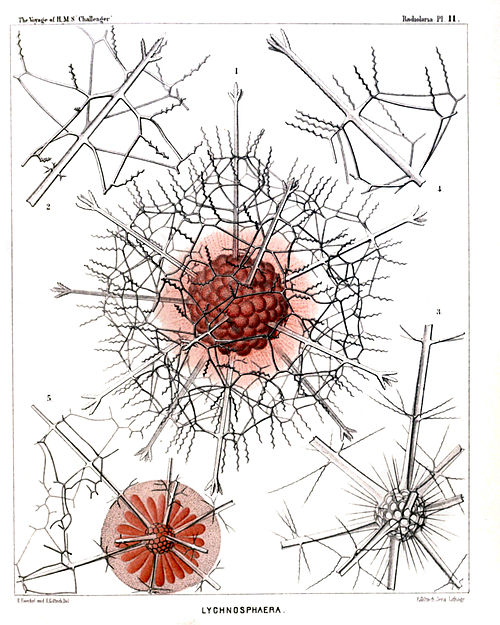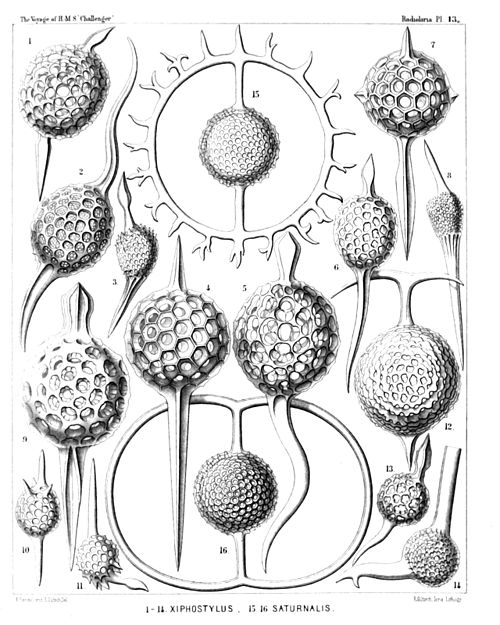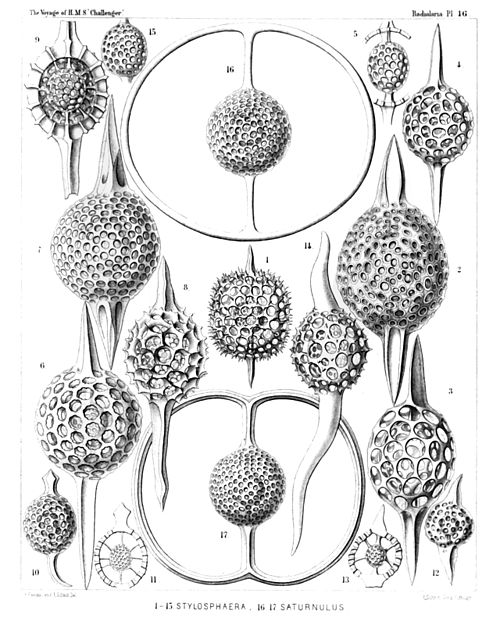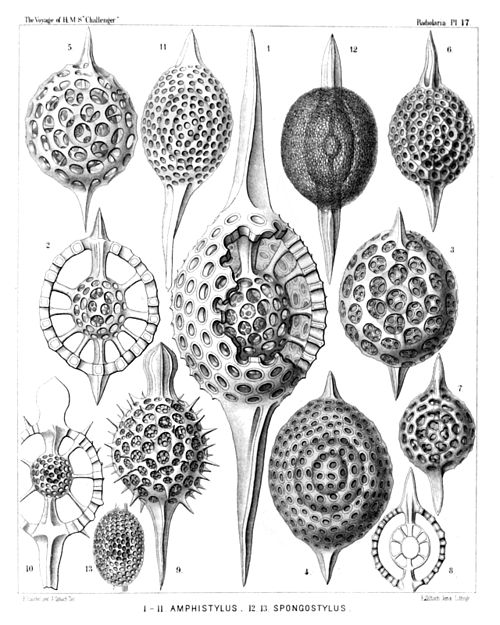PLATE 11.
Astrosphærida .
Diam.
Page.
Fig. 1. Lychnosphæra regina , n. sp.,
×
200
277
The entire shell and the central capsule. Numerous club-shaped radial apophyses or cœcal sacs arise from the pink central capsule and are protruded through the pores of the medullary shell, which is completely hidden by them. The sarcomatrix in the calymma, surrounding the central capsule, exhibits a fine radial striation. Numerous retracted pseudopodia, bearing red granules, arise from the sarcomatrix and pierce the calymma radially. The interval between the two concentric shells is filled up by the hyaline calymma.
Fig. 2. Lychnosphæra regina , n. sp.,
×
400
277
A part of the cortical shell, with a radial spine.
Fig. 3. Lychnosphæra regina , n. sp.,
×
400
277
The medullary shell and the basal parts of the radial spines arising from it.
Fig. 4. Lychnosphæra regina , n. sp.,
×
400
277
Distal end of a radial spine.
Fig. 5. Rhizoplegma lychnosphæra , n. sp.,
×
200
276
The central capsule and the enclosed parts of the skeleton. The protoplasm is radially striped. The central nucleus (red) sends out numerous radial apophyses, which are protruded through the pores of the medullary shell.
Plate 11.
Orders PHÆOSPHÆRIA et SPHÆROIDEA.
Families Orosphærida Astrosphærida Liosphærida
PLATE 12.
Orosphærida , Astrosphærida et Liosphærida .
Diam.
Page.
Fig. 1. Orosphæra huxleyii , n. sp. (vel Oroscena huxleyii ),
×
50
1599
Fig. 1a . A piece of the network, the bars of which contain partly an axial canal,
×
200
1599
Fig. 2. Conosphæra orthoconus , n. sp.,
×
200
221
Fig. 3. Conosphæra platyconus , n. sp.,
×
300
221
Fig. 4. Conosphæra plagioconus , n. sp.,
×
300
222
Fig. 5. Ethmosphæra conosiphonia , n. sp.,
×
400
69
Fig. 5a . Vertical section through the wall.
Fig. 6. Ethmosphæra polysiphonia , n. sp.,
×
400
70
Fig. 7. Cenosphæra compacta , n. sp.,
×
300
65
Fig. 8. Cenosphæra elysia , n. sp.,
×
300
64
Fig. 8a . Vertical section through the wall.
Fig. 9. Cenosphæra mellifica , n. sp.,
×
300
62
Fig. 10. Cenosphæra favosa , n. sp.,
×
300
62
Fig. 10a . Vertical section through the wall.
Fig. 11. Cenosphæra vesparia , n. sp.,
×
300
62
Fig. 11a . Vertical section through the wall.
Plate 12.
Orders SPHÆROIDEA et PRUNOIDEA.
Families Stylosphærida Ellipsida
PLATE 13.
Stylosphærida et Ellipsida .
Diam.
Page.
Fig. 1. Ellipsostylus aquila , n. sp.,
×
300
300
Fig. 2. Ellipsostylus hirundo , n. sp.,
×
300
301
Fig. 3. Ellipsostylus columba , n. sp.,
×
300
300
Fig. 4. Xiphostylus alcedo , n. sp.,
×
400
127
Fig. 5. Xiphostylus edolius , n. sp.,
×
400
130
Fig. 6. Ellipsostylus psittacus , n. sp.,
×
400
300
Fig. 7. Stylostaurus caudatus , n. sp.,
×
400
157
Fig. 8. Ellipsostylus ciconia , n. sp.,
×
300
300
Fig. 9. Xiphostylus phasianus , n. sp.,
×
400
127
Fig. 10. Xiphostylus trochilus , n. sp.,
×
300
129
Fig. 11. Xiphostylus emberiza , n. sp.,
×
300
131
Fig. 12. Saturnalis circoideus , n. sp.,
×
400
132
Not fully developed.
Fig. 13. Xiphostylus alca , n. sp.,
×
300
130
Fig. 14. Xiphostylus falco , n. sp.,
×
300
130
Fig. 15. Saturnalis rotula , n. sp.,
×
400
133
Fig. 16. Saturnalis annularis , n. sp.,
×
400
132
Plate 13.
Orders SPHÆROIDEA et PRUNOIDEA.
Families Stylosphærida Ellipsida
PLATE 14.
Stylosphærida et Ellipsida .
Diam.
Page.
Fig. 1. Ellipsoxiphus atractus , n. sp.,
×
300
298
Fig. 2. Xiphosphæra venus , n. sp.,
×
300
123
Fig. 3. Ellipsoxiphus claviger , n. sp.,
×
300
297
Fig. 4. Xiphosphæra pallas , n. sp.,
×
400
124
Fig. 5. Xiphosphæra gæa , n. sp.,
×
400
123
Fig. 6. Xiphosphæra vesta , n. sp.,
×
300
126
Fig. 7. Ellipsoxiphus elegans , n. sp., var. palliatus ,
×
400
296
Fig. 8. Lithapium halicapsa , n. sp.,
×
300
303
Fig. 9. Lithapium pyriforme , n. sp.,
×
300
303
Fig. 10. Lithapium monocyrtis , n. sp.,
×
300
304
Fig. 11. Ellipsoxiphus bipolaris , n. sp.,
×
600
297
Fig. 12. Xiphostylus trogon , n. sp.,
×
400
129
Fig. 13. Xiphostylus picus , n. sp.,
×
300
129
Fig. 14. Lithomespilus flammabundus , n. sp.,
×
400
303
Fig. 15. Xiphostylus alauda , n. sp.,
×
400
128
Fig. 16. Lithomespilus phloginus , n. sp.,
×
600
302
Fig. 17. Lithomespilus phlogoides , n. sp.,
×
600
302
Plate 14.
Orders SPHÆROIDEA et PRUNOIDEA.
Families Staurosphærida Druppulida
PLATE 15.
Staurosphærida et Druppulida .
Diam.
Page.
Fig. 1. Cromyatractus tetracelyphus , n. sp.,
×
300
335
Fig. 1a . The two inner medullary shells.
Fig. 2. Cromyatractus tetraphractus , n. sp.,
×
300
335
Fig. 3. Cromyatractus cepicius , n. sp.,
×
300
336
The spongy distal part of a polar spine.
Fig. 4. Cromyatractus ceparius , n. sp. (vel Caryostylus ceparius ),
×
300
336
Fig. 5. Staurolonche pertusa , n. sp.,
×
300
159
Fig. 5a . Its medullary shell.
Fig. 6. Staurosphæra philippi , n. sp.,
×
300
154
Fig. 7. Stauroxiphus gladius , n. sp.,
×
400
163
Fig. 8. Staurocaryum arborescens , n. sp.,
×
300
167
Fig. 9. Rhizoplegma radicatum , n. sp.,
×
200
276
Fig. 9a . The medullary shell, which is completely hidden in fig. 9 by the numerous club-shaped apophyses of the central capsule.
Plate 15.
Orders SPHÆROIDEA et PRUNOIDEA.
Families STYLOSPHÆRIDA Druppulida
PLATE 16.
STYLOSPHÆRIDA et Druppulida .
Diam.
Page.
Fig. 1. Stylosphæra melpomene , n. sp.,
×
300
135
Fig. 2. Lithatractus jugatus , n. sp., (vel Stylosphæra jugata ),
×
400
323
Fig. 3. Lithatractus fragilis , n. sp. (vel Stylosphæra fragilis ),
×
400
319
Fig. 4. Stylosphæra lithatractus , n. sp.,
×
300
The entire shell.
Fig. 5. Stylosphæra lithatractus , n. sp.,
×
300
The greater part of the cortical shell and the two spines taken off.
The description of Stylosphæra lithatractus (intermediate between Stylosphæra jugata and Stylosphæra terpsichore , p. 137 ) is by mistake not given in the text.
Fig. 6. Stylosphæra calliope , n. sp.,
×
400
134
Fig. 7. Stylosphæra clio , n. sp.,
×
400
134
Fig. 8. Druppatractus ostracion , n. sp.,
×
300
326
The entire shell.
Fig. 9. Druppatractus ostracion , n. sp.,
×
300
326
The anterior half of the cortical shell has been removed.
Fig. 10. Druppatractus hippocampus , n. sp.,
×
300
324
The entire shell.
Fig. 11. Druppatractus hippocampus , n. sp.,
×
300
324
The greater part of the cortical shell has been removed.
Fig. 12. Stylosphæra nana , n. sp.,
×
300
136
The entire shell
Fig. 13. Stylosphæra nana , n. sp.,
×
300
136
The greater part of the cortical shell taken off.
Fig. 14. Sphærostylus ophidium , n. sp.,
×
300
140
The entire shell.
Fig. 15. Sphærostylus ophidium , n. sp.,
×
300
140
The medullary shell alone.
Fig. 16. Saturnulus ellipticus , n. sp.,
×
400
141
Fig. 17. Saturnulus planetes , n. sp.,
×
400
142
Plate 16.
Orders SPHÆROIDEA et PRUNOIDEA.
Families Stylosphærida Druppulida Spongurida
PLATE 17.
Stylosphærida , Druppulida et Spongurida .
Diam.
Page.
Fig. 1. Stylatractus giganteus , n. sp. (vel Amphistylus giganteus ),
×
300
329
Fig. 2. Stylatractus sethoporus , n. sp.,
×
400
330
The greater part of the cortical shell taken off.
Fig. 3. Stylatractus sethoporus , n. sp.,
×
400
330
The entire cortical shell.
Fig. 4. Stylatractus compactus , n. sp.,
×
400
329
Fig. 5. Amphisphæra cronos , n. sp. (vel Amphistylus cronos ),
×
400
144
Fig. 6. Stylatractus neptunus , n. sp. (vel Amphisphæra neptunus ),
×
300
328
Fig. 7. Amphisphæra pluto , n. sp.,
×
300
144
The entire cortical shell.
Fig. 8. Amphisphæra pluto , n. sp.,
×
300
144
Meridional section through the three concentric shells.
Fig. 9. Xiphatractus glyptodon , n. sp.,
×
400
334
The entire cortical shell.
Fig. 10. Xiphatractus glyptodon , n. sp.,
×
400
334
The greater part of the cortical shell taken off.
Fig. 11. Xiphatractus armadillo , n. sp.,
×
400
332
Fig. 12. Spongoxiphus prunococcus , n. sp.,
×
300
354
The spongy cortical shell.
Fig. 13. Spongoxiphus prunococcus , n. sp.,
×
600
354
The two concentric latticed medullary shells.
Plate 17.
Families Liosphærida Astrosphærida
PLATE 18.
Liosphærida et Astrosphærida .
Diam.
Page.
Fig. 1. Centrocubus cladostylus , n. sp.,
×
100
278
Fig. 2. Octodendron spathillatum , n. sp.,
×
300
280
The entire inner shell, but a small part only of the outer shell is represented.
Fig. 3. Octodendron cubocentron , n. sp.,
×
400
279
The central capsule (somewhat irregular by compression?) exhibits a large excentric nucleus (probably dislocated artificially?).
Fig. 4. Octodendron spathillatum , n. sp.,
×
800
280
Free distal end of a radial spine, with the spathillæ on the end of the branches.
Fig. 5. Rhizosphæra serrata , n. sp.,
×
300
284
Fig. 6. Rhizosphæra serrata , n. sp.,
×
300
284
Medullary shell.
Fig. 7. Rhizosphæra serrata , n. sp.,
×
600
284
A single radial spine.
Fig. 8. Plegmosphæra exodictyon , n. sp.,
×
200
89
The central shell-cavity encloses the spherical central capsule and the concentric nucleus.
Fig. 9. Spongodrymus elaphococcus , n. sp.,
×
150
272
The entire inner shell, but only a small part of the outer spongy envelope is represented.
Plate 18.
PLATE 19.
Astrosphærida .
Diam.
Page.
Fig. 1. Drymosphæra polygonalis , n. sp.,
×
200
249
Fig. 2. Leptosphæra hexagonalis , n. sp.,
×
200
244
Showing the central capsule (forming numerous club-shaped protuberances) and the simple spherical nucleus in its centre. The skeleton is nearly the same as in Diplosphæra hexagonalis (fig. 3).
Fig. 3. Diplosphæra hexagonalis , n. sp.,
×
200
246
The spherical central capsule, with radially striped protoplasm, is enclosed in the inner shell, and exhibits in its centre the clear spherical nucleus.
Fig. 4. Astrosphæra hexagonalis , n. sp.,
×
300
250
Fig. 5. Astrosphæra stellata , n. sp.,
×
300
251
The central capsule, enclosed in the inner shell, exhibits a distinct radial striation of the protoplasm, and in the centre a clear spherical nucleus.
Fig. 6. Haliomma rhodococcus , n. sp. (vel Sethosphæra rhodococcus ),
×
400
237
The greater part of the outer shell is removed.
Plate 19.
Families Liosphærida Astrosphærida
PLATE 20.
Liosphærida et Astrosphærida .
Diam.
Page.
Fig. 1. Drymosphæra dendrophora , n. sp.,
×
300
249
Fig. 1a . Meridional section through the central capsule. In the centre the large spherical nucleus is visible. The protoplasm around it is distinctly radiate. From the central capsule arise numerous club-shaped apophyses or cæcal sacs, which are protruded through the meshes of the inner shell,
×
300
Fig. 1b . Basal part of a single radial spine, and its connection with the network of the two shells,
×
400
Fig. 2. Liosphæra polypora , n. sp.,
×
300
78
The greater part of the outer shell is removed.
Fig. 3. Liosphæra hexagonia , n. sp.,
×
400
76
Fig. 4. Carposphæra melitomma , n. sp. (vel Melitomma melittosphæra ),
×
400
73
Plate 20.










